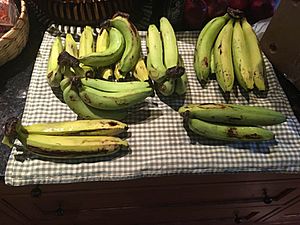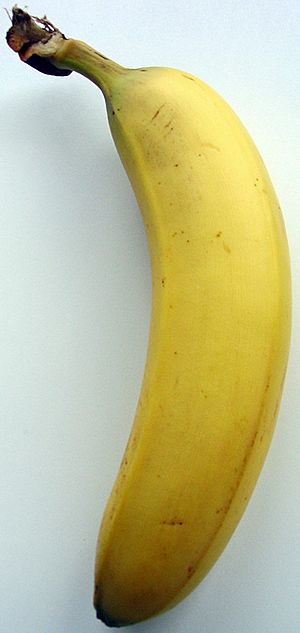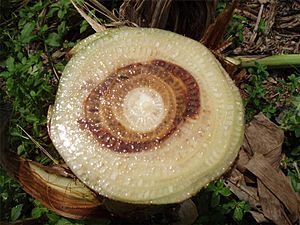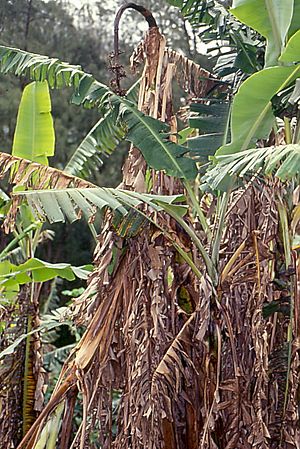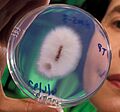Panama disease facts for kids
Quick facts for kids Panama disease |
|
|---|---|
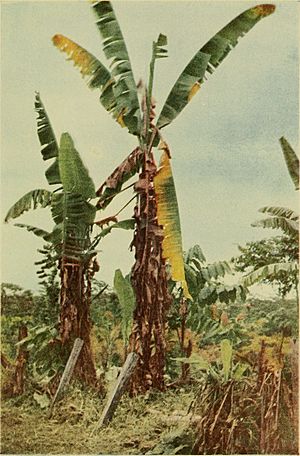
Gros Michel banana affected by disease, Costa-Rica, 1919
|
|
| Common names | Panama disease Fusarium wilt of banana Vascular wilt of banana |
| Causal agents | Fusarium oxysporum f.sp. cubense |
| Hosts | banana |
| Vectors | water, soil residues, replanting of suckers, farming tools and transport, leaf trash |
| EPPO Code | FUSACB |
| Distribution | Indonesia, China, Malaysia, Australia, the Philippines, Jordan, Vietnam, Laos, Pakistan, Lebanon, Mozambique, Oman |
Panama disease (also called Fusarium wilt) is a serious plant disease that attacks banana plants. It makes the plants wilt, which means they droop and dry out. This disease is caused by a tiny fungus called Fusarium oxysporum f. sp. cubense (Foc).
This fungus is very strong and cannot be easily stopped by fungicides (chemicals that kill fungi). So, controlling the disease mostly involves special rules to prevent its spread.
Back in the 1950s, Panama disease nearly destroyed all the bananas of a type called 'Gros Michel'. This was the most popular banana at the time. The disease caused huge problems and forced farmers to switch to other types of bananas that could resist the fungus.
Today, a new version of Panama disease, called Tropical Race 4 (TR4), is threatening the 'Cavendish banana'. This is the most common banana we eat today.
Contents
What is Panama Disease?
Wild bananas have big, hard seeds, but most bananas we eat do not have seeds. This means new banana plants are grown from parts of old plants, like their underground stems called offshoots.
Even if a banana plant is sick with the F. oxysporum fungus, its offshoots might look healthy. This is how the fungus often spreads to new places. It can also travel in soil, water, or on farm tools.
Panama disease is one of the most damaging plant diseases in recent history. It is thought to have started in Southeast Asia. It was first seen in Australia in 1876. By 1950, it had spread to almost all banana-growing areas around the world.
How it Affected Bananas
Panama disease can harm many types of bananas. But it is most famous for the damage it did to the 'Gros Michel' banana. Before 1960, almost all bananas sold around the world were 'Gros Michel'.
This type of banana was very sensitive to the disease. Using infected offshoots to plant new farms caused huge losses. For example, in Honduras, 30,000 hectares (about 74,000 acres) of banana farms were completely wiped out between 1940 and 1960.
By the mid-1900s, farmers started using 'Cavendish' bananas instead of 'Gros Michel'. For a while, these 'Cavendish' bananas were strong against the disease. They grew well and became the main type of banana sold.
Sadly, in some parts of the world, 'Cavendish' bananas are now getting sick from a new version of the disease called TR4. In 2019, TR4 was found in Colombia. This is a big problem because there are no other good types of bananas to replace 'Cavendish' yet.
Experts believe that watching for the disease, managing pests, growing new resistant bananas, and using genetic engineering can help. They think these efforts will be worth the investment.
A type of 'Cavendish' banana from Taiwan, called Formosana, was thought to have some resistance to TR4. However, some experts later said it might not be resistant at all. Another Taiwanese 'Cavendish' called 'GCTCV-119' is used because it resists TR4.
To make things worse, TR4 also affects plantains. Plantains are a very important food in many tropical countries. The average person in the United States eats a lot of 'Cavendish' bananas each year. People are now wondering if this popular fruit could disappear.
Besides the bananas sold around the world, about 85% of bananas are grown for local use. Many of these local types are also at risk from the disease.
Where the Disease Spreads
Not all banana-growing countries have been hit by Panama disease. Tropical Race 4 (TR4) was first found in Taiwan. From there, it quickly spread to Indonesia, China, Malaysia, Australia, and the Philippines.
In 2013, the disease was found in Jordan. TR4 then spread to Vietnam and Laos. It also appeared in the Middle East, in Pakistan and Lebanon. In 2015, the disease reached Africa, being reported in Mozambique and Oman. In August 2019, TR4 arrived in Colombia. This country is in Latin America, which is where the world's biggest banana exporters are located.
What it Looks Like (Symptoms)
When the F. oxysporum fungus infects a banana plant, the plant tries to fight back. It creates a gel that blocks the tubes that carry water and nutrients. This stops water and food from reaching the upper parts of the plant.
The fungus first attacks the tips of the roots. Then it moves into the underground stem. You can often see a dark stain where the stem connects to the roots. As the disease gets worse, large parts of the plant's water-carrying tubes turn reddish-brown.
Outside the plant, the oldest leaves start turning yellow. The lower part of the outer leaf covers on the plant's false stem often split. The leaves begin to wilt and may bend at their base. As the disease grows, younger leaves also turn yellow and crumple. Soon, the whole plant looks like it's dying.
It can be tricky to tell Panama disease apart from another disease called Xanthomonas wilt.
- With Panama disease, leaves usually turn yellow and wilt from the oldest to the youngest. They might also snap and hang down.
- With Xanthomonas wilt, any leaf can start wilting, and they tend to snap along the leaf blade.
Two main outside signs help identify Panama disease:
- Yellow leaf syndrome: The edges of the leaves turn yellow, and eventually the leaf stem bends.
- Green leaf syndrome: In some banana types, the leaves stay green but still bend at the stem.
Inside the plant, the disease causes the water-carrying tubes to change color. They start yellow in the roots and turn reddish-brown in the false stem. This happens because the fungus blocks the plant's water and food supply.
As the infection gets worse, the banana's false stem can split. Eventually, the whole plant collapses and dies.
It's also important to know the difference between Panama disease and bacterial wilt of banana:
- Panama disease affects older leaves first, then younger ones. Bacterial wilt does the opposite.
- Panama disease does not affect new buds or suckers. It also doesn't cause any liquid to ooze from the plant or affect the fruit. Bacterial wilt can cause twisted or dead buds, ooze, and rotten fruit.
Once a banana plant is infected, it rarely gets better. If new shoots grow, they will already be infected and can spread the disease if planted.
Life Cycle of the Fungus
Modern banana farms grow bananas using asexual reproduction. This means they replant shoots that grow from the base of an old plant. Since these bananas do not have seeds, all bananas of one type are almost exactly alike. This makes it easy for the fungus to spread because all the plants have the same defenses.
The disease spreads through tiny spores or infected plant parts. These can travel in water or during farming activities. A big problem is how new banana plants are started. Farmers take shoots from one plant to grow new trees. About 30-40% of shoots from a sick plant are infected, even if they look healthy. This means new infected plants can easily be grown.
The fungus can also live in certain weeds without showing symptoms. This means it can survive even when there are no banana plants around. Then, when bananas are planted later, the fungus is already there.
The fungus can survive in the soil for up to 30 years in special resting spores called chlamydospores. When conditions are right, and there are banana roots nearby, these spores sprout. The fungus then enters the roots and starts the infection. The disease often gets worse when the banana flowers appear. The most plants get sick right before harvest.
Once inside the plant, the fungus makes more spores that spread through the plant's water system. The infection spreads throughout the plant. It causes yellowing and bending of leaves, starting with the older ones. Eventually, the whole plant dies.
How it Spreads
The main ways the fungus spreads are by rain splashing it, by contaminated soil moving, and by moving infected plant parts. It is not proven that wind alone spreads the disease. Animals can carry the fungus on their bodies, but it's not clear if they spread the disease effectively.
History of the Disease
The 'Gros Michel' Disaster
The 'Gros Michel' banana was the only type of banana eaten in the United States from the late 1800s until after World War II. The disease was first found in banana farms in Panama in Central America. Over many years, the fungus spread from Panama to nearby countries. It moved north through Costa Rica to Guatemala and south into Colombia and Ecuador.
The banana industry faced a huge crisis. So, a new banana type, the 'Cavendish', was found. It was thought to be safe from Panama disease. In a few years, the damaged farms were back in business. The change to 'Cavendish' went smoothly in the American market.
Soon after, Malaysia started growing bananas. 'Cavendish' banana farms were new there in the 1980s. But they quickly grew to meet demand. Thousands of acres of rainforests and old palm oil farms were turned into banana farms. Within a few years, the new plants started dying. It took time to figure out, but the cause was Panama disease again.
Even though 'Cavendish' was thought to be safe, it was only safe from the fungus that destroyed 'Gros Michel'. That version of the fungus was only in the Western Hemisphere. But the version found in Malaysian soil was different. The 'Cavendish' banana was not safe from it. This new version killed plants and spread faster. It caused even more worry than the first one. This newly found fungus was named tropical race 4 (TR4).
The TR4 Disaster
Tropical Race 4 (TR4) was found in Taiwan in 1989. In 2013, countries in Latin America made a plan to deal with TR4. In March 2015, banana growers in Latin America met to create a plan to protect their region.
Scientists are trying to change the banana plant to make it resistant to Panama disease and other serious banana problems. These problems include infections from fungi, bacteria, and viruses, as well as tiny worms and beetles. Researchers are looking in faraway jungles for new wild bananas. They are also creating hybrid bananas, hoping to find a new type that can strongly resist diseases.
Some people believe that genetic engineering offers the best hope for a stronger banana. However, the new fruit also needs to taste good, ripen at the right time, travel long distances without damage, and be easy to grow in large amounts. Right now, no banana type or hybrid meets all these needs.
Australia's Efforts to Stop the Spread
In Queensland, Australia, a farm in Tully was put under quarantine in March 2015 after TR4 was found. Some plants were destroyed. After a short stop, harvesting was allowed again under strict rules to prevent spread. The government says it is not possible to completely get rid of the fungus. Researchers say the disease will keep spreading if bananas that are easily infected are still grown.
Experts have praised Queensland's quick and effective response to TR4. This response is now being copied by other countries. So far, TR4 has been kept only in the Tully Valley. Stopping people from accidentally moving the fungus and preventing its spread in water are key to keeping it contained.
TR4 Reaches Colombia
In August 2019, officials in Colombia declared a national emergency. They confirmed that Panama disease had reached Latin America. One expert said, "Once you see it, it is too late, and it has likely already spread outside that zone without recognition."
Fighting the Disease
Since fungicides do not work well, there are few ways to manage Panama disease. Using chemicals to clean the soil did reduce the disease for about three years. But then the fungus came back. Injecting plants with certain chemicals might help, but the results are not clear. Heating the soil has also been tried, but the fungus usually comes back.
The best hope for fighting this disease in infected soils is to create bananas that are resistant through genetic modification. Early research into the fungus was often done by large companies that wanted to protect their banana farms.
In Australia, moving and selling banana plant parts is strictly controlled. This helps slow down the spread of TR4 and other banana diseases. Scientists have found a gene called RGA2 that is completely effective against TR4. This gene is not active in 'Cavendish' bananas, but it is active in another type of banana. It might be possible to make 'Cavendish' bananas express this gene using CRISPR technology.
Some chemicals made by bacteria have been found to be harmful to the fungus. However, most chemicals and other treatments have not worked well against Panama disease in the field. The most common methods used are cleaning and quarantine to stop the disease from spreading.
The most effective way to fight Panama disease is to develop banana plants that are resistant to the fungus. Because bananas are grown from clones, there are not many different types. This makes it hard to breed new resistant types. Creating clones from tissue cultures (small pieces of plant grown in a lab) has helped. But these new types sometimes do not grow as well or produce as much fruit. Still, these efforts are leading to the best ways to control Panama disease.
In 2017, a gene that resists disease was put into 'Cavendish' bananas. These bananas showed resistance to TR4 in field tests. One group of eight plants showed resistance for three years.
Researchers in Taiwan believe that TR4 started because the soil was damaged by chemical fertilizers.
One study in 2020 found that growing chili peppers and bananas in a rotation helped a lot to stop the disease. This idea might also help in raising livestock.
Scientists are still studying how different types of bananas resist the fungus.
Why Breeding Bananas is Hard
One big problem in breeding new bananas is that 'Gros Michel' and 'Cavendish' bananas are triploid. This means they have three sets of chromosomes instead of the usual two. Because of this, their flowers usually cannot make good seeds. Only very rarely do they produce a few seeds.
If a new banana type is created this way, it will have seeds. But people are not used to eating bananas with seeds. Also, trying to breed these new bananas further has not worked well.
The Honduras Foundation for Agricultural Research grows several types of 'Gros Michel' bananas. They have managed to produce a few seeds by hand-pollinating the flowers with pollen from other banana types that have two sets of chromosomes.
Images for kids
See also
 In Spanish: Enfermedad de Panamá para niños
In Spanish: Enfermedad de Panamá para niños


